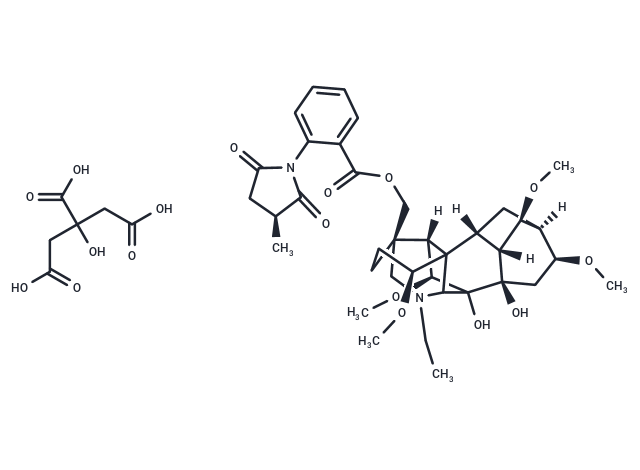Shopping Cart
- Remove All
 Your shopping cart is currently empty
Your shopping cart is currently empty

Methyllycaconitine citrate (MLA) is an α7 neuronal nicotinic acetylcholine receptor (α7nAChR) antagonist that crosses the blood-brain barrier.

| Pack Size | Price | Availability | Quantity |
|---|---|---|---|
| 5 mg | $249 | In Stock |
| Description | Methyllycaconitine citrate (MLA) is an α7 neuronal nicotinic acetylcholine receptor (α7nAChR) antagonist that crosses the blood-brain barrier. |
| In vitro | Pretreatment with 5 and 10 µM Methyllycaconitine citrate inhibited the decreased cell viability induced by Aβ25–35, which suggested that Methyllycaconitine citrate had a protective effect against Aβ-induced cytotoxicity. Furthermore, cell viability did not decrease after exposure to Methyllycaconitine citrate (2.5, 5, 10, 20 uM), which suggests a good safety profile[1]. |
| In vivo | The effect of MLA on acute METH-induced effects and neurotoxicity in mice was tested using an in vivo model. The results indicate that MLA (6 mg/kg) inhibited 50% of the METH-induced climbing behavior[2]. |
| Alias | MLA |
| Molecular Weight | 874.92 |
| Formula | C43H58N2O17 |
| Cas No. | 351344-10-0 |
| Smiles | OC(=O)CC(O)(CC(O)=O)C(O)=O.[H][C@]12C[C@]3([H])[C@]([H])([C@H]1OC)[C@](O)(C[C@@H]2OC)C1(O)[C@@H](OC)[C@@]2([H])C33C1N(CC)C[C@]2(COC(=O)c1ccccc1N1C(=O)C[C@H](C)C1=O)CC[C@@H]3OC |
| Relative Density. | no data available |
| Storage | keep away from moisture,store at low temperature | Powder: -20°C for 3 years | In solvent: -80°C for 1 year | Shipping with blue ice. | ||||||||||||||||||||||||||||||||||||||||
| Solubility Information | DMSO: 100 mg/mL (114.30 mM), Sonication is recommended. H2O: 1 mg/mL (1.14 mM), Sonication is recommended. | ||||||||||||||||||||||||||||||||||||||||
Solution Preparation Table | |||||||||||||||||||||||||||||||||||||||||
H2O/DMSO
DMSO
| |||||||||||||||||||||||||||||||||||||||||

Copyright © 2015-2024 TargetMol Chemicals Inc. All Rights Reserved.